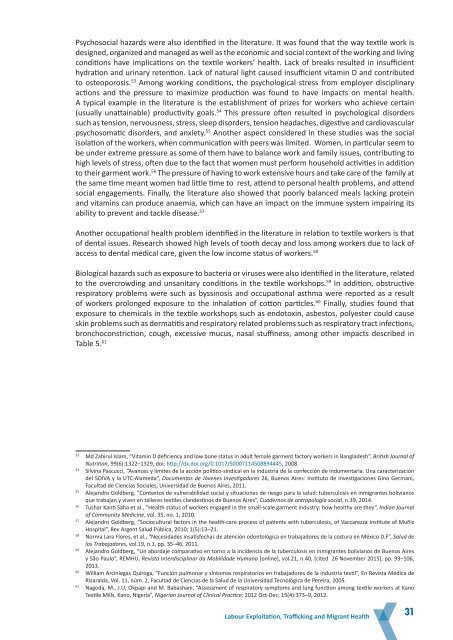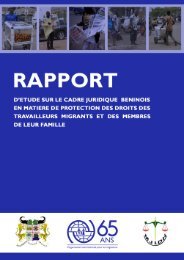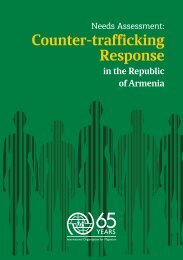Labour Exploitation Trafficking and Migrant Health
labour_exploitation_trafficking_en_0
labour_exploitation_trafficking_en_0
You also want an ePaper? Increase the reach of your titles
YUMPU automatically turns print PDFs into web optimized ePapers that Google loves.
Psychosocial hazards were also identified in the literature. It was found that the way textile work is<br />
designed, organized <strong>and</strong> managed as well as the economic <strong>and</strong> social context of the working <strong>and</strong> living<br />
conditions have implications on the textile workers’ health. Lack of breaks resulted in insufficient<br />
hydration <strong>and</strong> urinary retention. Lack of natural light caused insufficient vitamin D <strong>and</strong> contributed<br />
to osteoporosis. 53 Among working conditions, the psychological stress from employer disciplinary<br />
actions <strong>and</strong> the pressure to maximize production was found to have impacts on mental health.<br />
A typical example in the literature is the establishment of prizes for workers who achieve certain<br />
(usually unattainable) productivity goals. 54 This pressure often resulted in psychological disorders<br />
such as tension, nervousness, stress, sleep disorders, tension headaches, digestive <strong>and</strong> cardiovascular<br />
psychosomatic disorders, <strong>and</strong> anxiety. 55 Another aspect considered in these studies was the social<br />
isolation of the workers, when communication with peers was limited. Women, in particular seem to<br />
be under extreme pressure as some of them have to balance work <strong>and</strong> family issues, contributing to<br />
high levels of stress, often due to the fact that women must perform household activities in addition<br />
to their garment work. 56 The pressure of having to work extensive hours <strong>and</strong> take care of the family at<br />
the same time meant women had little time to rest, attend to personal health problems, <strong>and</strong> attend<br />
social engagements. Finally, the literature also showed that poorly balanced meals lacking protein<br />
<strong>and</strong> vitamins can produce anaemia, which can have an impact on the immune system impairing its<br />
ability to prevent <strong>and</strong> tackle disease. 57<br />
Another occupational health problem identified in the literature in relation to textile workers is that<br />
of dental issues. Research showed high levels of tooth decay <strong>and</strong> loss among workers due to lack of<br />
access to dental medical care, given the low income status of workers. 58<br />
Biological hazards such as exposure to bacteria or viruses were also identified in the literature, related<br />
to the overcrowding <strong>and</strong> unsanitary conditions in the textile workshops. 59 In addition, obstructive<br />
respiratory problems were such as byssinosis <strong>and</strong> occupational asthma were reported as a result<br />
of workers prolonged exposure to the inhalation of cotton particles. 60 Finally, studies found that<br />
exposure to chemicals in the textile workshops such as endotoxin, asbestos, polyester could cause<br />
skin problems such as dermatitis <strong>and</strong> respiratory related problems such as respiratory tract infections,<br />
bronchoconstriction, cough, excessive mucus, nasal stuffiness, among other impacts described in<br />
Table 5. 61<br />
53<br />
Md Zahirul Islam, “Vitamin D deficiency <strong>and</strong> low bone status in adult female garment factory workers in Bangladesh”, British Journal of<br />
Nutrition, 99(6):1322–1329, doi: http://dx.doi.org/0.1017/S0007114508894445, 2008.<br />
54<br />
Silvina Pascucci, “Avances y límites de la acción político-sindical en la industria de la confección de indumentaria. Una caracterización<br />
del SOIVA y la UTC-Alameda”, Documentos de Jóvenes Investigadores 26, Buenos Aires: Instituto de Investigaciones Gino Germani,<br />
Facultad de Ciencias Sociales, Universidad de Buenos Aires, 2011.<br />
55<br />
Alej<strong>and</strong>ro Goldberg, “Contextos de vulnerabilidad social y situaciones de riesgo para la salud: tuberculosis en inmigrantes bolivianos<br />
que trabajan y viven en talleres textiles cl<strong>and</strong>estinos de Buenos Aires”, Cuadernos de antropología social, n.39, 2014.<br />
56<br />
Tushar Kanti Saha et al., “<strong>Health</strong> status of workers engaged in the small-scale garment industry: how healthy are they”, Indian Journal<br />
of Community Medicine, vol. 35, no. 1, 2010.<br />
57<br />
Alej<strong>and</strong>ro Goldberg, “Sociocultural factors in the health-care process of patients with tuberculosis, of Vaccarezza Institute of Muñiz<br />
Hospital”, Rev Argent Salud Pública, 2010; 1(5):13–21.<br />
58<br />
Norma Lara Flores, et al., “Necesidades insatisfechas de atención odontológica en trabajadores de la costura en México D.F”, Salud de<br />
los Trabajadores, vol.19, n.1, pp. 35–46, 2011.<br />
59<br />
Alej<strong>and</strong>ro Goldberg, “Un abordaje comparativo en torno a la incidencia de la tuberculosis en inmigrantes bolivianos de Buenos Aires<br />
y São Paulo”, REMHU, Revista Interdisciplinar da Mobilidade Humana [online], vol.21, n.40, [cited 26 November 2015], pp. 93–106,<br />
2013.<br />
60<br />
William Arciniegas Quiroga, “Función pulmonar y síntomas respiratorios en trabajadores de la industria textil”, En Revista Médica de<br />
Risaralda, Vol. 11, núm. 2, Facultad de Ciencias de la Salud de la Universidad Tecnológica de Pereira, 2005.<br />
61<br />
Nagoda, M., J.U, Okpapi <strong>and</strong> M. Babashani, “Assessment of respiratory symptoms <strong>and</strong> lung function among textile workers at Kano<br />
Textile Mills, Kano, Nigeria”, Nigerian Journal of Clinical Practice; 2012 Oct-Dec; 15(4):373–9, 2012.<br />
<strong>Labour</strong> <strong>Exploitation</strong>, <strong>Trafficking</strong> <strong>and</strong> <strong>Migrant</strong> <strong>Health</strong><br />
31





